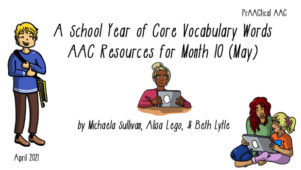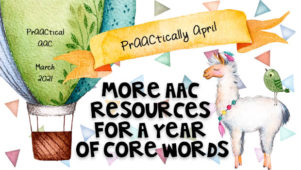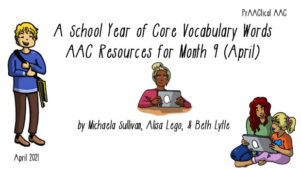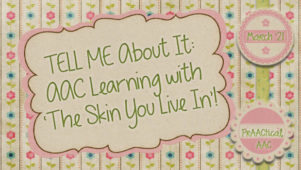Core Concepts in Core Vocabulary Instruction

We’ve been talking about implementing A Year of Core Words and A(nother) Year of Core Words for our March words. If you are new to the idea, it involves highlighting a different set of set of 12-16 core words each month to help our AAC learners get progressively more familiar with their vocabulary options. Today, we’re linking to some posts with ideas for what to do with the core words for each month.
Laying the Foundation
Give learners access to core vocabulary in their communication books, SGDs, and/or AAC apps.
Prepare the core vocabulary materials for the month. If you haven’t started, don’t sweat it. Just download, print, and give it a go. “A year from now, you will wish you had started today” (K. Lamb). We are ALL a work in progress.
Use the core words in an AAC system when you speak. Whether we call it aided language stimulation, aided language input, aided modeling, or just modeling, the idea is the same. To teach a new way of communicating, use it yourself. That gives the AAC learner a competent model of what it looks and sounds like to communicate in this way. We all learned language by hearing competent speakers, and our AAC friends are no different in that respect. The more incidental exposure they get to us using AAC, the faster they will learn. No baby ever learned language from hearing it only during speech therapy. It just doesn’t work that way.
Provide focused language stimulation on the target words. You can read about that here and here.
Move Forward
Create opportunities for adults, peers, and AAC learners to use the core words. We wrote several posts about this that you can take a look at. Here are a few from the archives.
- Meaningful Communication Opportunities
- Mining Preschool Routines for AAC Opportunities
- PrAACtical Play: Creating Opportunities with Favorite Toys
- From Disney Princesses to Houseplants: More on Building Communication Opportunities
Teach Word Meaning
If these words are new to your AAC learners, then this is the time to implement robust semantic intervention. Here are some past posts that might be helpful.
- Vocabulary Instruction in AAC
- Thoughts on Teaching Core Vocabulary
- Teaching Core With Direct Instruction Strategies
- Core Words, Direct Instructional Strategies, and the Beginning Communicator
- New Word Teaching: A Look Inside Some PrAACtical Therapy Sessions
- Complete Vocabulary Instruction Ideas
- Explicitly Speaking: Vocabulary Instruction in AAC
- Building Word Consciousness in AAC Vocabulary Instruction
- Ideas About Vocabulary Instruction for the Beginning Communicator
Embedded within some of these posts are links to others with specific activities, apps, and ideas for implementation.
Filed under: PrAACtical Thinking
Tagged With: Another Year of Core Words, core vocabulary, semantics, Year of Core Words
This post was written by Carole Zangari





2 Comments
Hello, I am a SLP at an elementary school. I have a 5th grade CD student who is using a Maestro. Within structured activities, she is able to put 3-4 icons together. This is using one page with all the icons that she needs. She is still working to navigate to specific pages, but of course has her favorites!! I am wondering how I would go about teaching core vocabulary as you have outlined?? Do I create one new page a month to help teach the words? I am uncertain how I would create her pages to make them most easily accessible to her. Thank you in advance for your suggestions.
Melissa, thanks for stopping by. This is SUCH a good question and I am glad that you asked it. The Year of Core Words approach is designed to support you in teaching more and more core words every month in order to teach kids to be more effective with their AAC tools. The starting point is giving them access to an AAC pageset (or communication book, or SGD or AAC app) that is rich in core words. The short answer is that you want to put her on a page set w/in her SGD that has a lot of core words. You can mask many of them at first and reveal new ones over time. It doesn’t work very well to put them all on the same page, b/c then the overall linguistic structure doesn’t make sense. In general, a better option would be to start with something with well-designed core (like Gateway 40 or 60 which is already in her device), hide some of the words for now, then show a few new ones each week. Obviously, one size doesn’t fit all, but most students who can put 3-4 symbols together in structured activities are ready for more language than we usually give them. Does that help?